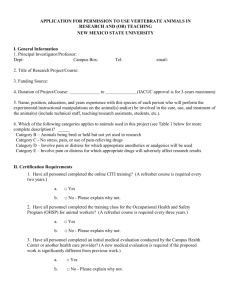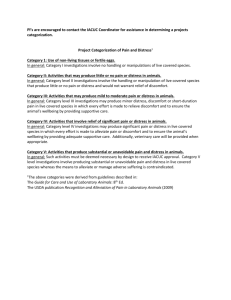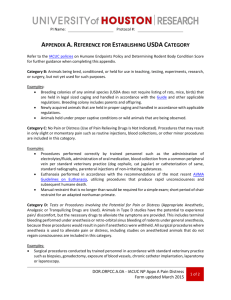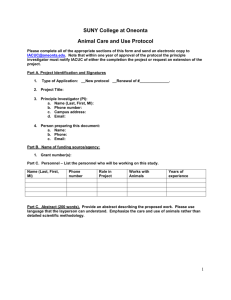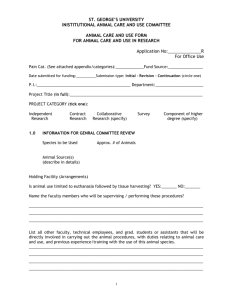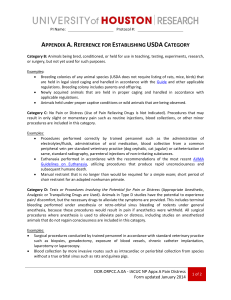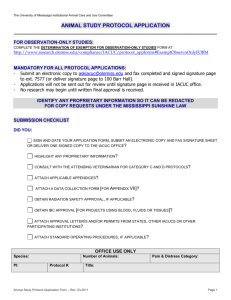Lab animal Care - eweb.furman.edu
advertisement
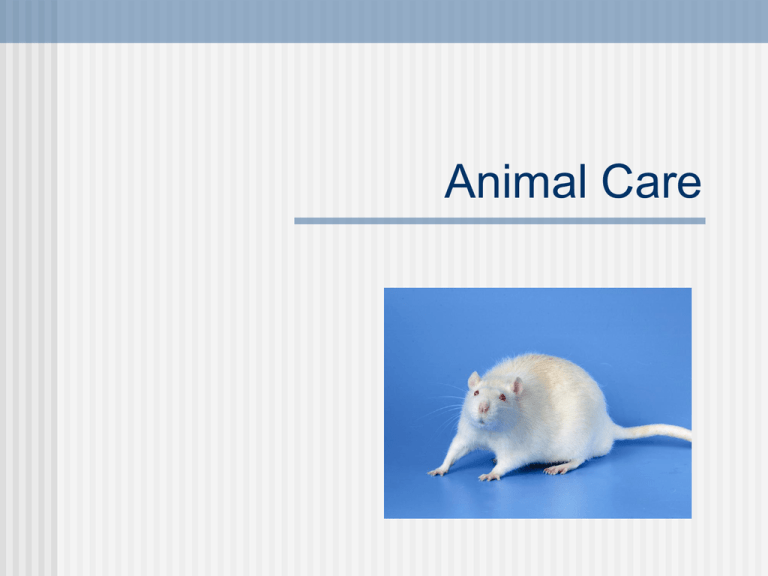
Animal Care Overview Some people are troubled by the use of animals in research. Each individual must make decisions about the kind of research he/she wishes to perform. Overview Some people are troubled by the use of animals in research. Each individual must make decisions about the kind of research he/she wishes to perform. Ethical issues are complex. Not much consensus among professional ethicists. New Zealand granted basic rights to five great ape species in 1999. Their use is now forbidden in research, testing or teaching. Overview Some people are troubled by the use of animals in research. Each individual must make decisions about the kind of research he/she wishes to perform. Ethical issues are complex. Not much consensus among professional ethicists. Legally, federal and state laws recognize and regulate the ownership, care, and use of many kinds of animals. Laws Regulating Care and Use of Animals Migratory Bird Treaty Act - 1918 U.S., Canada, Mexico, Russia, Japan Under the Act, taking, killing or possessing migratory birds or eggs is unlawful. Laws Regulating Care and Use of Animals Animal Welfare Act, 1966 prohibits sale or use of stolen animals prohibits animal fighting ventures (e.g., dogs) requires humane care of animals used as pets, in exhibits (zoos, circuses), on farms, in research Enforced by US Dept. of Agriculture • Animal & Plant Health Inspection Service (APHIS) Criminal penalties for violation Covers most birds & mammals, but not rodents Laws Regulating Care and Use of Animals Marine Mammal Protection Act, 1972 Protects marine mammals, including research animals and performing dolphins, killer whales, etc. Enforced by Natl. Oceanographic & Atmospheric Administration (NOAA), Office of Protected Resources Endangered Species Act, 1973 Protects endangered and threatened species Enforced by US Dept. of Interior • Fish and Wildlife Service (USFWS) Laws Regulating Care and Use of Animals Health Research Extension Act, 1985 Covers ALL live vertebrates used in research Rules were developed by Inter-agency Research Animal Committee Rules are summarized in the Guide for the Care and Use of Laboratory Animals, plus a large body of additional literature. Enforcement is by National Institutes of Health Penalties are mostly grant-related, not criminal Laws Regulating Care and Use of Animals Great Ape Protection and Cost Savings Act, 2011 U.S. and Gabon are only two countries still using apes in research. This act would prohibit their use in invasive research (observation allowed) Also establishes a sanctuary for experimental apes Issues covered in the Guide for the Care and Use of Laboratory Animals (by National Research Council) Institutional oversight committees Animal housing and management Veterinary care Euthanasia Institutional Animal Care and Use Committee (IACUC) More commonly called “Animal Care Committee” All institutions that use animals in research must have an IACUC, or if not, must have their projects approved by an IACUC at a neighboring institution. IACUC oversees compliance with regulations and evaluates proposals to use vertebrate animals. Animal Care and Use Committee Makeup Vet, practicing scientist, nonscientist, someone not affiliated with the institution, at least one other person (5) Underlying principles Use of animals can benefit society But it should be done so as to minimize distress Mostly an ethical issue But also, a distressed animal produces unreliable experimental results The decision to approve a proposed use of animal subjects involves weighing: The amount of unavoidable distress The potential societal benefit Justification for using animals I. Why is this the right animal model? A. Research should be undertaken with a clear scientific purpose. B. There should be a reasonable expectation that the research will: • 1. Increase knowledge of the processes underlying the evolution, development, maintenance, alteration, control, or biological significance of behavior • 2. Increase understanding of the species under study • 3. Provide results that benefit the health or welfare of humans or other animals. Justification for using animals II. Does an animal need to be used? i.e., are there alternative models? III. What is the minimal number of animals needed? Animal acquisition I. Bred in the laboratory II. Licensed dealer A. Animals not bred in the facility are to be acquired lawfully. B. The USDA and local ordinances should be consulted for information regarding regulations and approved suppliers. II. Field collections A. Animals taken from the wild should be trapped in a humane manner and in accordance with applicable federal, state, and local regulations. Animal acquisition III. Endangered species or taxa A. Should be used only with full attention to required permits and ethical concern Transportation Issues I. Proper packaging II. Timely shipping III. Appropriate care upon arrival Once the animals arrive: Adequate Veterinary Care Consultation with the principal investigator to minimize pain and distress. What is “distress”? Pain, suffering, fear Assumptions that: Invertebrates experience distress less than vertebrates. “Lower” vertebrates experience distress less than more advanced ones, because simpler brains have less capacity to remember past events and to conceptualize and anticipate future events. PI Responsibilities A. Minimize pain and distress 1. Appropriate pain relieving drugs • Unless withholding such drugs is justified for scientific reasons, in writing, by the principal investigator and will continue only for the necessary period of time. 2. Not include the use of paralytics without anesthesia. (This is a flat prohibition). 3. Animals that would otherwise experience severe or chronic pain or distress that cannot be relieved will be painlessly euthanized. PI Responsibilities A. 4. The animals living conditions will be appropriate for their species in accordance with standards that will contribute to their health and comfort. 5. Medical care for animals will be available and provided as necessary by a qualified veterinarian. 6. Activities that involve surgery must include appropriate provision for pre-operative and postoperative care of the animals in accordance with established veterinary medical and nursing practices PI Responsibilities A. 7. All survival surgery will be performed using aseptic procedures, including surgical gloves, masks, sterilized instruments, and aseptic techniques. 8. No animal will be used in more that one major operative procedure from which it is allowed to recover unless: • a. Justified for scientific reasons by the principal investigator, in writing. • b. Required as routine veterinary procedure or to protect the health or well-being of the animal as determined by the attending veterinarian. PI Responsibilities B. Ensure that personnel conducting procedures on the species being maintained or studied are appropriately qualified and trained in those procedures. C. Humane methods of animal maintenance and experimentation. 1. The basic needs of each species of animal. 2. Proper handling and care for the various species of animals used by the facility 3. Proper pre-procedural and post-procedural care of animals. 4. Aseptic surgical methods and procedures. PI Responsibilities C. 1. The concept, availability, and use of research or testing methods that limit the use of animals or minimize animal distress 2. Proper use of pain relieving drugs for any species of animals used by the facility. 3. Methods whereby deficiencies in animal care and treatment are reported, including deficiencies reported by facility employees Housing Standards I. Heating, cooling, and temperature II. Ventilation III. Compatible groupings IV. Exercise V. Food and water VI.Psychological well-being Disposal The return of wild-caught animals to the field can carry substantial risks To the formerly captive animals and to the ecosystem. Animals reared in the laboratory should not be released • In most cases, they cannot survive or they may survive by disrupting the natural ecology. Proper (humane) euthanasia
